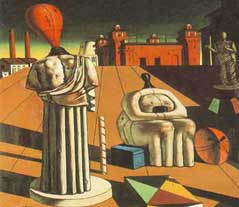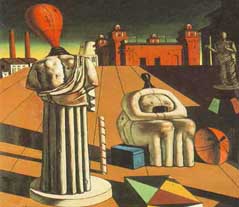 The Palazzo delle Esposizioni in Rome is hosting a great exhibition dedicated to the Italian artist and founder of metaphysical art movement: Giorgio De Chirico. Born of an Italian noble family in 1888 in Greece, he was educated in Munich where he was influenced by the philosopher Nietzsche.
The Palazzo delle Esposizioni in Rome is hosting a great exhibition dedicated to the Italian artist and founder of metaphysical art movement: Giorgio De Chirico. Born of an Italian noble family in 1888 in Greece, he was educated in Munich where he was influenced by the philosopher Nietzsche.
The aim of his art was “Painting that which cannot be seen,” as the artist used to say.
He dedicated his entire life trying to paint something hidden beyond the visible reality. The result was Metaphysical Art, one of the most fertile cultural movements of 20th century. This art wants to capture "the eternity of the moment" in paint.
The exhibition examines more then 100 paintings in seven different sections. They come from some of the most important public and private collections, with works that have been rarely shown.
An important part of the exhibition is dedicated to a constant theme in De Chirico’s work: Nature, transfigured in a mythical key. In another section, it is possible to see figures evoked by mythology, from the Bible or from historic legends.
In de Chirico's paintings, unreal shadows play the important role of volumes and solids.
De Chirico is an extraordinary architect of hallucinatory and absurd cityscapes: in some paintings, familiar objects from everyday life, such as armchairs and cupboards, are displaced under an open sky, as if they were part of the nature; in other compositions rocks and trees are domesticated inside a room. Some other works of art are dedicated to the “Chinese boxes”: here the paintings show rooms within rooms, images within the images. De Chirico died in Rome in 1978.

